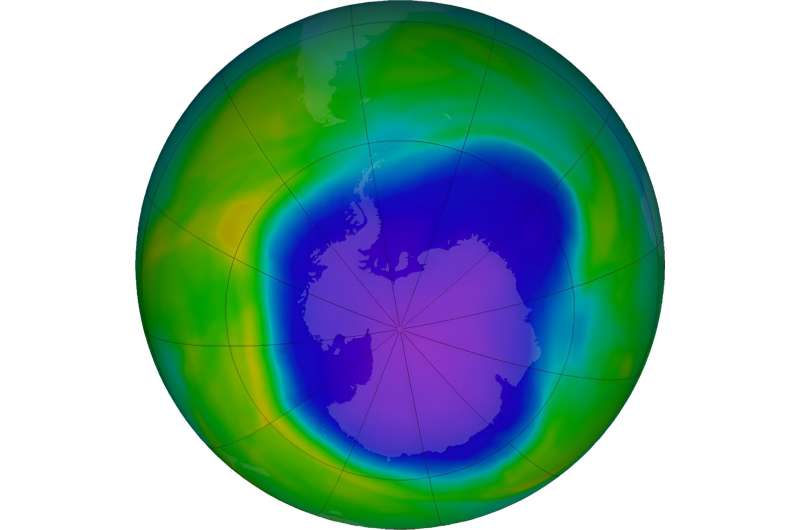This article has been reviewed according to Science X's editorial process and policies. Editors have highlighted the following attributes while ensuring the content's credibility:
fact-checked
peer-reviewed publication
trusted source
proofread
Study highlights need to keep an eye on the ozone hole

Despite public perception, the Antarctic ozone hole has been remarkably massive and long-lived over the past four years, University of Otago researchers believe chlorofluorocarbons (CFCs) aren't the only things to blame.
In a study, published in Nature Communications, the group analyzed the monthly and daily ozone changes, at different altitudes and latitudes within the Antarctic ozone hole, from 2004 to 2022.
Lead author Hannah Kessenich, Ph.D. candidate in the Department of Physics, says they found there is much less ozone in the center of the ozone hole compared to 19 years ago.
"This means that the hole is not only larger in area, but also deeper throughout most of spring.
"We made connections between this drop in ozone and changes in the air that is arriving into the polar vortex above Antarctica. This reveals the recent, large ozone holes may not be caused just by CFCs," she says.
While the Montreal Protocol on Substances that Deplete the Ozone Layer, which has been in place since 1987, regulates the production and consumption of man-made chemicals known to deplete the ozone, the researchers believe other complex factors are also contributing to the ozone hole.
"Most major communications about the ozone layer over the last few years have given the public the impression that the 'ozone issue' has been solved.
"While the Montreal Protocol has vastly improved our situation with CFCs destroying ozone, the hole has been among the largest on record over the past three years, and in two of the five years prior to that.
"Our analysis ended with data from 2022, but as of today the 2023 ozone hole has already surpassed the size of the three years prior—late last month it was over 26 million km2, nearly twice the area of Antarctica."
Kessenich believes understanding ozone variability is important because of the major role it plays in the Southern Hemisphere's climate.
"We all know about the recent wildfires and cyclones in Australia and New Zealand and the Antarctic ozone hole is part of this picture.
"While separate from the impact of greenhouse gases on climate, the ozone hole interacts with the delicate balance in the atmosphere. Because ozone usually absorbs UV light, a hole in the ozone layer can not only cause extreme UV levels on the surface of Antarctica, but it can also drastically impact where heat is stored in the atmosphere.
"Downstream effects include changes to the Southern Hemisphere's wind patterns and surface climate, which can impact us locally."
She is quick to allay fears about extreme UV rays, though. "New Zealanders need not worry about applying extra sunscreen this year as the Antarctic ozone hole is generally not open above New Zealand—it is mostly located directly over Antarctica and the South Pole."
More information: Annika Seppälä et al, Potential drivers of the recent large Antarctic ozone holes, Nature Communications (2023). DOI: 10.1038/s41467-023-42637-0. www.nature.com/articles/s41467-023-42637-0
Journal information: Nature Communications
Provided by University of Otago





















